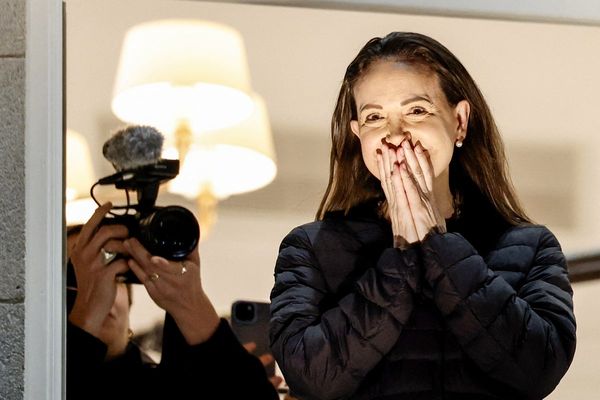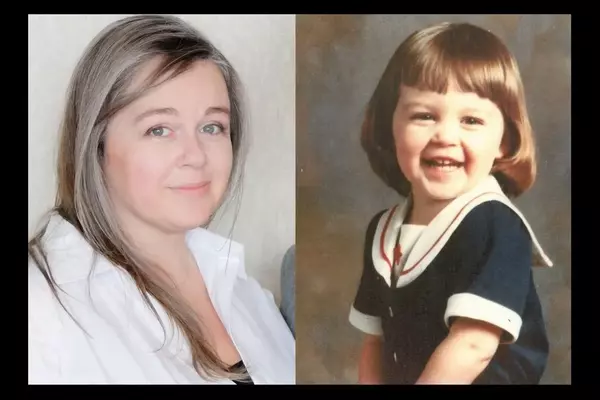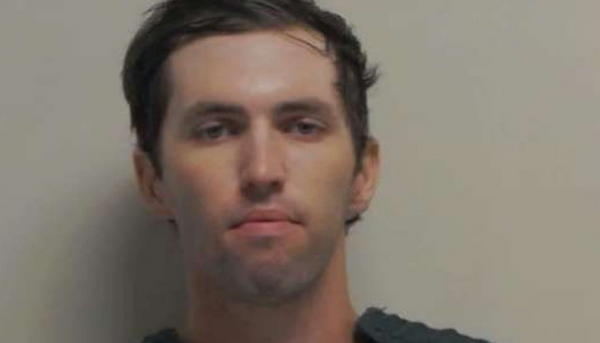
It’s 4pm on a Thursday and I’m in a sauna underground at the Art Gallery of NSW, the hot, cedarwood-scented air a sharp contrast to the cool concrete cavern I’ve just stepped in from. Inside the gallery’s subterranean Tank – a 2,200 sq metre chamber that was once a second world war oil reservoir – Sydney-based artist Mike Hewson has repurposed a 1980s shed, gutting its faux-wood veneer and replacing it with western red cedar, from which he’s also created ornate church-style pews for seating. The windows are now stained glass; the floor and ceiling are lined with travertine tiles left over from one of the gallery’s older wings.
Clearly, this is no ordinary sauna. It’s one of several surprising sculptural works in Hewson’s playful exhibition The Key’s Under the Mat, opening this weekend. There are also change rooms, a steam room, barbecue, sound recording studio, laundromat and playground – all fully functional. You can borrow towels, shorts, slides and T-shirts for free, or bring your own swimsuit (no bikinis).
Huddled in the sauna with curators Justin Paton and Emily Sullivan, my conversation with them quickly becomes relaxed. They return again and again to the idea of audience engagement – aware that it can feel like an “institutional buzzword” but wanting to push beyond mere “symbols of participation”. “How do you get people to dwell and feel like it’s their own space?” Paton asks. “What does it mean for a museum to be generous and welcoming?”
It’s a canny choice to commission Hewson, a former engineer who is famous for his site-specific and “risky” public playgrounds, such as Rocks on Wheels in Melbourne’s Southbank. That work, composed of huge bluestone boulders set on dolly-like bases, caused some consternation when it opened, but is now well loved and well used.
For Hewson, exposure to risk is not a flaw but the point. “You can’t escape danger,” he said in a 2022 Ted Talk. It’s an attitude forged by personal experience: in 2011 he lost his home and studio to the Ōtautahi Christchurch earthquakes. It catalysed an irreverent aesthetic that highlights uncertainty and impermanence.
Hewson’s punk-rock attitude belies a more earnest desire: for people of all ages to experience beauty in their immediate environment; to feel surprise, delight, and to connect with each other.
He crafts environments that demand trust, test our ease with uncertainty, and create resilience through play. “You have to have faith in what people do next,” Hewson says. “None of us knows what the future is.”
***
Shortly after the sauna, I enter a stainless steel milk vat, raising my temperature again. Salvaged from a junkyard in Port Fairy, it has been transformed by Hewson into a steam room, with stained-glass portals and a travertine bench. Marble panels nearby are remnants from the construction of the Opera Bar at Sydney Opera House. The room’s recycled concrete pavers are inset with glittering morsels of varied masonry – including scorched bricks from a decommissioned coke works in Wollongong, and granite, quartz and found objects.
The whole Tank space thrums with these material histories, something Hewson is drawn to again and again. For him, salvaged materials carry an energy of their own – stories that can be retold and reimagined in new settings.
The playground is his ideal interface, and ripe for innovation. Local playgrounds are often bland and risk-averse, but Hewson sees their sculptural potential. He is attentive not just to the slides and swings but to what he calls the “playground periphery”: the benches, shade and spillover spaces where parents and neighbours gather. For the AGNSW exhibition, he asks: “How far into the community can the periphery go?”
His answer is to conjure the simple joys of an Australian summer – underground: “The show is a warm afternoon, kids running around and bombing into the pool, a barbecue, music,” he says.
Translating that vision into the Tank is no small feat. Sixty lights made from repurposed plastic pallet tanks wrapped in bubble wrap flood the space with artificial daylight strong enough to sustain a number of palm trees. Custom-made acoustic curtains soften the cavern’s echoes. A raised floor conceals plumbing and electrical systems.
A conspicuously large barbecue plate sits near the middle of the space, with a few leftover chips from someone’s lunch still on one of the grill plates, two bottles of Heinz tomato sauce next to it. (“We should have put some sausages on before you got here,” Hewson says when I arrive). During the exhibition, this space, which is fitted with a custom exhaust system, will function like any public barbecue: BYO food and utensils; clean up after yourself.
So many aspects of the exhibition feel risky in a gallery context, and Paton says “the history of the show is a history of propositions that [at] first seemed impossible”.
But sitting in the space before the opening, talking with the artist and curators while we sit on flipped buckets, there’s a palpable sense of ease and openness. “When you let someone into your house, you have to trust them,” Hewson says. “Let them be free.”
For the artist, the real artwork will only begin when people arrive. “The test is the energy,” he says. “It’s the people running around that is the work.”
It feels less like an exhibition than a gathering in the making: the smell of a barbecue, music waiting to start, the promise of conversation carrying through the Tank. A party is about to begin – and all of Sydney is invited.
Mike Hewson: The Key’s Under the Mat opens 4 October at Art Gallery of New South Wales, Naala Badu building, Nelson Packer Tank







